 TEL:
+86-13102802206
TEL:
+86-13102802206
 Email:
fencenetting@china.com
Email:
fencenetting@china.com
 Language
Language
 TEL:
+86-13102802206
TEL:
+86-13102802206
 Email:
fencenetting@china.com
Email:
fencenetting@china.com
 Language
Language


Understanding Construction Fence Cost
When embarking on a construction project, one of the often-overlooked expenses is the cost of fencing. Construction fences play a vital role in securing the site, protecting the workers, and ensuring the safety of the public. Understanding the factors influencing construction fence costs can help project managers and contractors make informed decisions and budget effectively.
Types of Construction Fences
The type of fencing used on construction sites can vary significantly depending on the specific needs of the project. The most common types include chain-link fences, plastic barrier fences, and wooden fences.
1. Chain-link Fences These are among the most popular choices due to their durability and ability to provide visibility while keeping unauthorized individuals out. Typically, chain-link fences are sold by the linear foot, with costs generally ranging from $10 to $20 per foot, depending on the height and gauge of the wire.
2. Plastic Barrier Fences Also known as safety or silt fences, these are lightweight and easy to install. They are primarily used for temporary applications, such as for site safety and crowd control. Costs for plastic fencing can range from $5 to $15 per linear foot, making them an economical choice for short-term projects.
3. Wooden Fences While wooden fences provide a more aesthetic appeal, they are less common for construction sites due to higher costs and lower durability. However, they are sometimes used in residential projects or where appearance matters, costing around $15 to $30 per linear foot.
Factors Affecting Cost
Several factors can influence the overall cost of construction fencing, including

2. Site Conditions The specific conditions of the construction site can affect installation costs. Uneven terrain, for example, may require additional labor and materials to secure the fence properly.
3. Duration of Rental For temporary fencing solutions, the length of time the fence is needed for can impact costs significantly. Most companies offer rental agreements, and the longer the fence is rented, the higher the overall cost.
4. Additional Features Adding gates, barbed wire, privacy slats, or other features will also drive up costs. For instance, a gate installation can add $200 to $1,000 to the total fencing cost, depending on its size and type.
5. Permitting and Regulations Depending on local regulations, permits may be required for construction fencing. These can add to the overall expense and should be accounted for during the budgeting phase.
Budgeting for Fencing
When estimating costs, it's crucial to gather quotes from multiple suppliers to ensure competitive pricing. This should include not just materials but installation costs as well. Additionally, consider budgeting for potential damages or maintenance, as wear and tear on fencing during construction can lead to unexpected expenses.
Conclusion
Understanding construction fence costs is essential to the successful management of any construction project. By evaluating the types of fencing available, understanding the factors influencing costs, and planning for the budget, contractors can ensure that their sites remain secure and compliant with safety regulations while keeping expenses under control. Proper planning and foresight can lead to a more efficient project and help avoid unnecessary delays and costs.